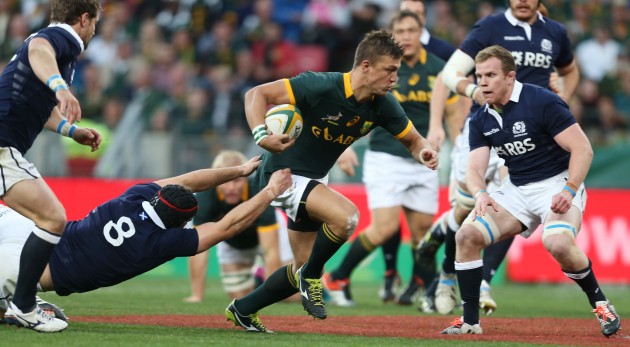Heyneke Meyer is changing the Springboks’ mindset as they strive for an all-court game, but has he left it too late to forge a World Cup-winning team?
The Sharks beat the Bulls last week and probably put paid to the Pretorians’ hopes of a Currie Cup semi-final berth. Former Springbok coach, Nick Mallett, continually linked to coaching vacancies but happy spouting his thoughts as a TV pundit, hit the nail on the head when pinpointing the Bulls’ failings.
“They’re still playing a forward-dominated kicking game, with up-and-unders and box kicking that was successful for them in the past,” he said. “They’re trying to move into a more ball-in-hand approach but they’ve never played a 15-man, phase play, coordinated type of game plan.
“The players don’t really know where to run. They have back-line players cleaning rucks and forwards playing fly-half. There’s a whole strategy of playing attacking rugby using all 15 players and they don’t really understand how to do that.”
It’s a theme he’s touched on before as you can see from a rant from this year’s Super 15 – and it gets to the heart of South Africa’s problems as they build towards next year’s World Cup. The Springboks are caught between two stools.
If the Boks so chose, they could install Fourie du Preez (currently injured) and Morne Steyn at half-back. Du Preez could launch his deadly box kicks for Bryan Habana to chase, Steyn could kick for the corners and let Victor Matfield steal or spoil the lineout.
On their own throws, the Boks could maul opponents to distraction; last year more than 85% of their lineout drives brought a positive outcome, whether from a try (over 40%), a secondary penalty (over 30%) or a yellow card for the opposition. The Bulls’ drive in this year’s Super 15, with the forwards powering forward in long-ruck formation, was a thing of beauty.
Now, would any team, even the All Blacks, really fancy 80 minutes against a South Africa team playing this way?
Attacking fluidity
Actually yes, because rugby moves on and what worked once may not work now. The high-speed, up-tempo game is in the ascendency, as illustrated by the try glut in the Aviva Premiership, and the Boks are trying to adapt.
Pitches are better than ever, so most surfaces suit a quick game and reward sides willing to attack from all areas. You never know with the British weather, but the odds are that RWC 2015 will be played in conditions conducive to running rugby.
Boks coach Heyneke Meyer knows this, of course, and is broadening his team’s horizons.
Willie le Roux, a fast and skilful ball player, has been a breath of fresh air, even if his distribution let him down in Wellington this month. Steyn has been displaced by Handré Pollard, the IRB Junior Player of the Year, and Meyer must now have the courage of his convictions by picking the young fly-half in every Test.
The Boks’ back play was a bit lateral against New Zealand two weeks ago, but Pollard showed glimpses of what’s possible with him at the helm; his superb raking touch-finder created the position from which, off the lineout, he took the ball flat to the line, drew Ma’a Nonu and put Cornal Hendricks in for the try.
Matfield won nine lineouts in that match, and he commands there in a way that Eben Etzebeth and Flip van der Merwe cannot. But at 37 he’s vulnerable if the game is played at pace, and this is an issue for the team as a whole because the South African Super 15 franchises don’t play the expansive game that their SANZAR rivals do.
Has Meyer got time to condition the Boks for a faster game? In Wellington, they missed 31 tackles as they struggled to slow the All Blacks. They made half the carries (80 v New Zealand’s 162), a paltry one offload against 16, and only 80 passes against 235.
Bismarck benched
Despite the grisly stats, the four-point defeat was Meyer’s best result against the All Blacks in five attempts. And it was achieved for the most part without hooker Bismarck du Plessis, who came on for Adrian Strauss and contributed to five turnovers (three lineouts, two scrums) in about 15 minutes. Just to clarify, that means he helped give away possession.
It’s not long ago that the mighty du Plessis was the best player in the world, his impact in the loose staggering for such a big man. Now, he’s in danger of becoming a permanent replacement.
Strauss, who will wear No 2 for the third successive match on Saturday when Australia visit Cape Town, has made more starts than his rival under Meyer (17 against 14) and few are questioning the coach’s judgement. The Boks surely have the best two hookers in the world.
Du Plesssis may be out of form but if you can afford to leave a man like him on the bench then you have a squad to be envied. The Rugby Championship title is set to elude the Boks this year – a bonus-point win for the All Blacks in Argentina will give them the title with a round to spare – but their real objective is being ready by 19 September 2015, when they open their World Cup campaign against Japan in Brighton.
The clock is ticking and the regeneration of the Boks – partly in personnel but more in playing style – must be rapidly advanced. If they can learn to run the ball with the same expertise as they maul it, they will have a great chance of unseating New Zealand next year. Speed and power make for a potent and potentially winning mix.







